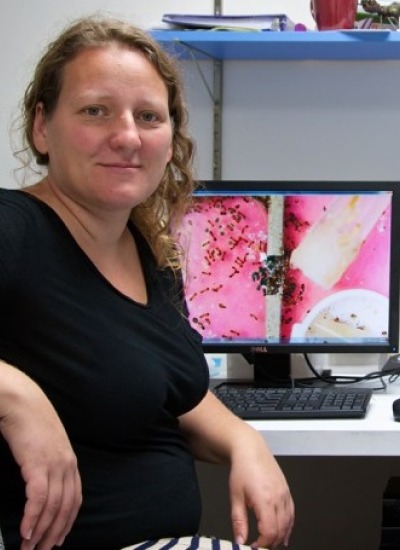Anna R Dornhaus
Publications
PMID: 12548429;Abstract:
Foragers of Bombus terrestris are able to alert their nestmates to the presence of food sources. It has been supposed that this happens at least partially through the distribution of a pheromone inside the nest. We substantiate this claim using a behavioral test in which an alerting signal is transmitted from one colony to another by long distance air transport, so excluding all other modalities of information exchange. We then investigated the source of the pheromone and were able to show that a hexane extract from tergites V-VII of bumble bee workers elicits higher activity, like a successful forager does. Extracts from other glands, such as the mandibular, labial, hypopharyngeal, and Dufour's gland as well as extracts from other parts of the cuticle had no effect. This suggests that bumble bees possess a pheromone-producing gland, similar to the Nasanov gland in honey bees. Indeed, an extract from the honey bee Nasanov gland also proved to alert bumblebee workers, suggesting a possible homology of the glands.
Abstract:
The importance of the spatial information which is communicated in the Camolian Race of the Western Honeybee, Apis mellifera carnica (Pollmann 1879) waggle dance relative to other cues used by bees in finding food sources was investigated. The efficiency of recruitment with and without transmission of direction information in the waggle dance was quantified using artificial, plentiful unscented food sources and hives which were turned to a horizontal position to disrupt orientation of dancing bees and thereby eliminate the spatial information from dances. Transmission of location information seems to improve recruitment effect particularly at large distances. Recruitment declines more rapidly with distance if dances are disoriented, and for large distances it takes a few hours before a foraging group is established. However, this shows that even without dance information, foragers manage to recruit some bees to their food source. This process, however, is so slow that by the time a group of recruits has reached the food source, it may not be worth exploiting any more. Transmission of spatial information thus is especially important if distant food sources which often change in nectar availability are exploited.
Abstract:
Bumble bees are important pollinators of crops and other plants. However, many aspects of their basic biology remain relatively unexplored. For example, one important and unusual natural history feature in bumble bees is the massive size variation seen between workers of the same nest. This size polymorphism may be an adaptation for division of labor, colony economics, or be nonadaptive. It was also suggested that perhaps this variation allows for niche specialization in workers foraging at different temperatures: larger bees might be better suited to forage at cooler temperatures and smaller bees might be better suited to forage at warmer temperatures. This we tested here using a large, enclosed growth chamber, where we were able to regulate the ambient temperature. We found no significant effect of ambient or nest temperature on the average size of bees flying to and foraging from a suspended feeder. Instead, bees of all sizes successfully flew and foraged between 16 °C and 36 °C. Thus, large bees foraged even at very hot temperatures, which we thought might cause overheating. Size variation therefore could not be explained in terms of niche specialization for foragers at different temperatures. © 2010 Margaret J. Couvillon et al.
Social insects live in colonies consisting of many workers, where worker interactions play an important role in regulating colony activities. Workers interact within the social space of the nest; therefore, constraints on nest space may alter worker behaviour and affect colony activities and energetics. Here we show in the ant Temnothorax rugatulus that changes in nest space have a significant effect on colony energetics. Colonies with restricted nest space showed a 14.2 per cent increase in metabolic rate when compared with the same colonies in large uncrowded nests. Our study highlights the importance of social space and shows that constraints on social space can significantly affect colony behaviour and energy use in ants. We discuss the implications of our findings regarding social insects in general.
Abstract:
Information about food sources can be crucial to the success of a foraging animal. We predict that this will influence foraging decisions by group-living foragers, which may sacrifice short-term foraging efficiency to collect information more frequently. This result emerges from a model of a central-place forager that can potentially receive information on newly available superior food sources at the central place. Such foragers are expected to return early from food sources, even with just partial loads, if information about the presence of sufficiently valuable food sources is likely to become available. Returning with an incomplete load implies that the forager is at that point not achieving the maximum possible food delivery rate. However, such partial loading can be more than compensated for by an earlier exploitation of a superior food source. Our model does not assume cooperative foraging and could thus be used to investigate this effect for any social central-place forager. We illustrate the approach using numerical calculations for honeybees and leafcutter ants, which do forage cooperatively. For these examples, however, our results indicate that reducing load confers minimal benefits in terms of receiving information. Moreover, the hypothesis that foragers reduce load to give information more quickly (rather than to receive it) fits empirical data from social insects better. Thus, we can conclude that in these two cases of social-insect foraging, efficient distribution of information by successful foragers may be more important than efficient collection of information by unsuccessful ones. © 2006 Springer-Verlag.


